I think it is fair to say that Lindsay Galvin is fast gaining a strong reputation for her historical writing; in which she sheds new light on people and events from the past. Her book “Darwin’s Dragons” was particularly memorable and emotional, so I must admit to having high expectations of this new work.
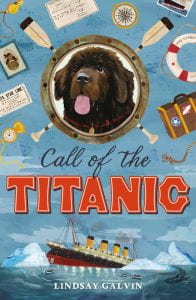 Most people probably think that they know the story of the Titanic, whether it is from the film of the same name, or from one of the many documentary programmes that have been televised over the years. Over the years I have been lucky enough to visit exhibitions about the ship, but of course the new Museum in Belfast really brings home the size and quality of the vessel. All of this gives us a very objective view of the ship and the catastrophe, but what Lindsay Galvin does is bring us to the heart and soul of the story.
Most people probably think that they know the story of the Titanic, whether it is from the film of the same name, or from one of the many documentary programmes that have been televised over the years. Over the years I have been lucky enough to visit exhibitions about the ship, but of course the new Museum in Belfast really brings home the size and quality of the vessel. All of this gives us a very objective view of the ship and the catastrophe, but what Lindsay Galvin does is bring us to the heart and soul of the story.
The story is told from two differing viewpoints and also following different time lines. On one hand, we have a fictionalised account of the testimony of Sid Daniels, a 14 year old steward (although 18 years old in real life), who was the last member of the crew to be saved by the Carpathia. His part of the story is shown as if written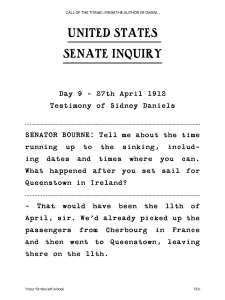 as testimony on a manual typewriter and it is fascinating to have this real sense that we are reading the original words. What strikes me as surprising is the dates given to the government enquiry, it is only two weeks after the actual tragedy and I can’t imagine that would happen in our modern
as testimony on a manual typewriter and it is fascinating to have this real sense that we are reading the original words. What strikes me as surprising is the dates given to the government enquiry, it is only two weeks after the actual tragedy and I can’t imagine that would happen in our modern 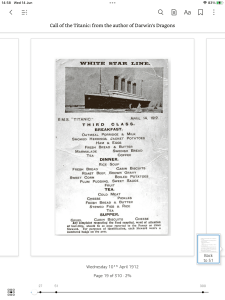 age. What also surprised me was the living conditions for the third class passengers that Sid was looking after. There is a perception that conditions for those lower down the ship were really atrocious, but what comes across here is that they were probably better off than they would have been back in their original homelands.
age. What also surprised me was the living conditions for the third class passengers that Sid was looking after. There is a perception that conditions for those lower down the ship were really atrocious, but what comes across here is that they were probably better off than they would have been back in their original homelands.
The other half of the story follows the ‘adventures of young Clara Scott (aged 12 years) who is accidentally locked in a trunk at the family farm and ends up on the Carpathia, where her cousin is the wireless operator Harold Cottam. When she finally escapes from the trunk, she is in the ship’s hold and has a gigantic Newfoundland dog keeping her company. What follows makes for an exciting adventure in its own right, but it is the sequence of events which make this such a chilling and yet unstoppable read. However the two stories eventually converge and the heroism shown that night becomes all too clear.
The author has made Clara the absolute centre of the story, with Sid and Rigel (the dog) coming in as a close joint second. At the beginning I was not sure what I felt about this young girl, as she is very strong minded and not prone to listening to others. However, this is shown to be beneficial, with her feisty and determined attitude overcoming the often bigoted attitudes of some of the crew and passengers. Lindsay Galvin has managed to paint a vivid and chilling scenario for one of the greatest tragedies of the 20th century. It is one of those books that you just can’t stop reading, so start reading it early in the day! As readers, we get a real sense of the research that has gone into the book and I found myself going off to check some details when I was reading. Perhaps the most poignant aspect of this story is the way that the author is able to convey the reality of the ordinary people who were caught up in the events. When major catastrophes take place we often forget about the ordinary people whose lives are devastated by what happens, but in this story the author has managed to bring these often unknown characters into the light.
This is one of those books where I feel that I am running out of superlatives, so it is probably best that I just finish by saying that everyone should read this book and it should find a home in every school and library. This definitely gets 5 stars and probably deserves more.
The author Lindsay Galvin
“Lindsay was lucky enough to be raised in a house of stories, music, and love of the sea. She left part of her heart underwater after living and working in Thailand where she spent hundreds of blissful hours scuba diving. Forced now to surface for breath, she lives in sight of the chillier Sussex sea with her husband and two sons. When she is not writing, she can be found reading, running or practicing yoga. She has a degree in English Language and Literature, is fascinated by psychology and the natural world, and teaches Science. Lindsay hadn’t written creatively since childhood until the idea for her debut novel The Secret Deep splashed into her mind, and she now she’s hooked.”
Thank you to the Chicken House website for this biographical information.

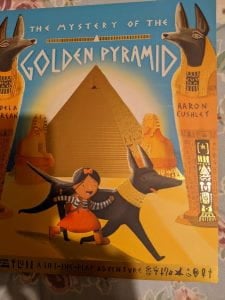 Ancient Egypt. When Sophie moves to Egypt, she is surprised to find a dog in her bedroom, but this is a talking dog who gives her a quest to find and return four lost amulets to the tomb of King Nebra. It is full of action and humour and will appeal to all KS1 children. The illustrations are excellent, with some great ‘lift-the-flap’ elements.
Ancient Egypt. When Sophie moves to Egypt, she is surprised to find a dog in her bedroom, but this is a talking dog who gives her a quest to find and return four lost amulets to the tomb of King Nebra. It is full of action and humour and will appeal to all KS1 children. The illustrations are excellent, with some great ‘lift-the-flap’ elements.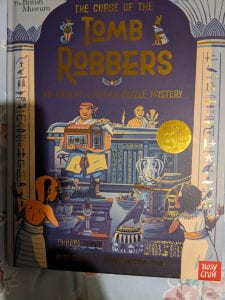 intrigue and tomb robbery, in which two children are able to foil the robbers and bring them to justice. It highlights the importance of reading the hieroglyphs and also the respect that was given to the dead, by the Egyptians.
intrigue and tomb robbery, in which two children are able to foil the robbers and bring them to justice. It highlights the importance of reading the hieroglyphs and also the respect that was given to the dead, by the Egyptians.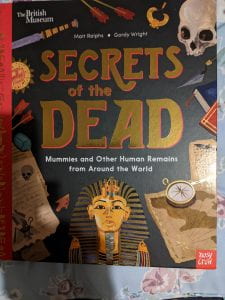 British Museum and looks at the various forms of mummification found around the world. Egypt is only one of those places, but the chapter in this book looks at the methods used and at some famous examples such as Tutankhamun and Ramses II. The book makes for a fascinating read.
British Museum and looks at the various forms of mummification found around the world. Egypt is only one of those places, but the chapter in this book looks at the methods used and at some famous examples such as Tutankhamun and Ramses II. The book makes for a fascinating read.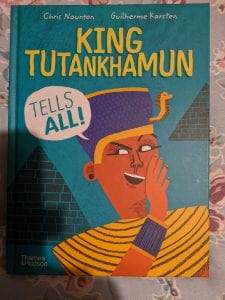 “King Tutankhamun tells all” by Chris Naunton and Guilherme Karsten is written by one of our most well-known and knowledgeable Egyptologists. The illustrations are cartoon style and full of colour and is written in the form of a memoir by the dead Pharaoh. There is a great deal of humour in the way that it is written, but it is still full of information about the king and also Ancient Egypt itself.
“King Tutankhamun tells all” by Chris Naunton and Guilherme Karsten is written by one of our most well-known and knowledgeable Egyptologists. The illustrations are cartoon style and full of colour and is written in the form of a memoir by the dead Pharaoh. There is a great deal of humour in the way that it is written, but it is still full of information about the king and also Ancient Egypt itself.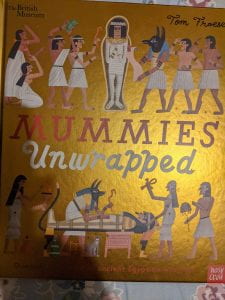 British Museum and is a fascinating look at the various processes that a mummy underwent; asking many of the questions that young people want to know.. The illustrations are bright clear and have elements of humour, which really adds to the enjoyment. The cover is gold, which will add to the attraction for the intended audience.
British Museum and is a fascinating look at the various processes that a mummy underwent; asking many of the questions that young people want to know.. The illustrations are bright clear and have elements of humour, which really adds to the enjoyment. The cover is gold, which will add to the attraction for the intended audience.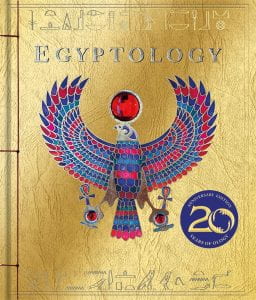 “Egyptology” by Dugald Steer is the first in a series of truly sumptuous books, full of illustrations, lift the flaps, added artifacts and information about a range of topics. this book has a gold cover and really gives the reader a sense of the grandeur that was found in Egyptian tombs. Whilst this is not a new title, it is one that should be the basis of anyone’s collection about Egypt.
“Egyptology” by Dugald Steer is the first in a series of truly sumptuous books, full of illustrations, lift the flaps, added artifacts and information about a range of topics. this book has a gold cover and really gives the reader a sense of the grandeur that was found in Egyptian tombs. Whilst this is not a new title, it is one that should be the basis of anyone’s collection about Egypt.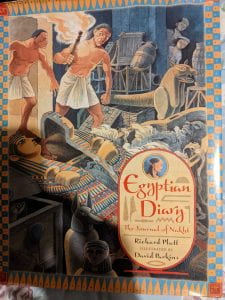 “Egyptian diary: The Journal of Nakht” by Richard Platt and David Parkins is the story of a young boy living in Memphis with his family and how he helps foil a gang of tomb robbers and eventually get to meet the Pharaoh Hatshepsut, only to discover that they are a woman (one of very few female pharaohs). this is a large size book with some fabulous illustrations. Since its publication in 2005 it has become a staple of all school libraries.
“Egyptian diary: The Journal of Nakht” by Richard Platt and David Parkins is the story of a young boy living in Memphis with his family and how he helps foil a gang of tomb robbers and eventually get to meet the Pharaoh Hatshepsut, only to discover that they are a woman (one of very few female pharaohs). this is a large size book with some fabulous illustrations. Since its publication in 2005 it has become a staple of all school libraries.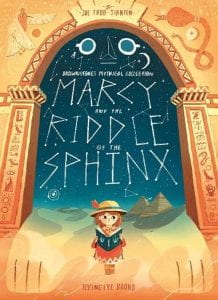 “Marcy and the Riddle of the Sphinx” by Joe Todd Stanton is the second tale in the “Brownstone’s Mythical collection” series and follows the adventures of Marcy, the daughter of the original hero Arthur, as she attempts to save her father from the clutches of the Great Sphinx. Children will love the graphic novel format and the fast pace of the action.
“Marcy and the Riddle of the Sphinx” by Joe Todd Stanton is the second tale in the “Brownstone’s Mythical collection” series and follows the adventures of Marcy, the daughter of the original hero Arthur, as she attempts to save her father from the clutches of the Great Sphinx. Children will love the graphic novel format and the fast pace of the action.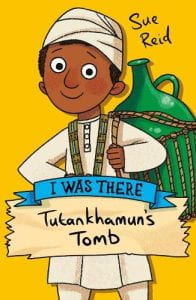 audiences. It is based on the fact that a young boy was involved in finding the stairs which led to the tomb discovery. it is full of action, villains and of course introduces the audience to Howard Carter and his patron Lord Caernarvon.
audiences. It is based on the fact that a young boy was involved in finding the stairs which led to the tomb discovery. it is full of action, villains and of course introduces the audience to Howard Carter and his patron Lord Caernarvon.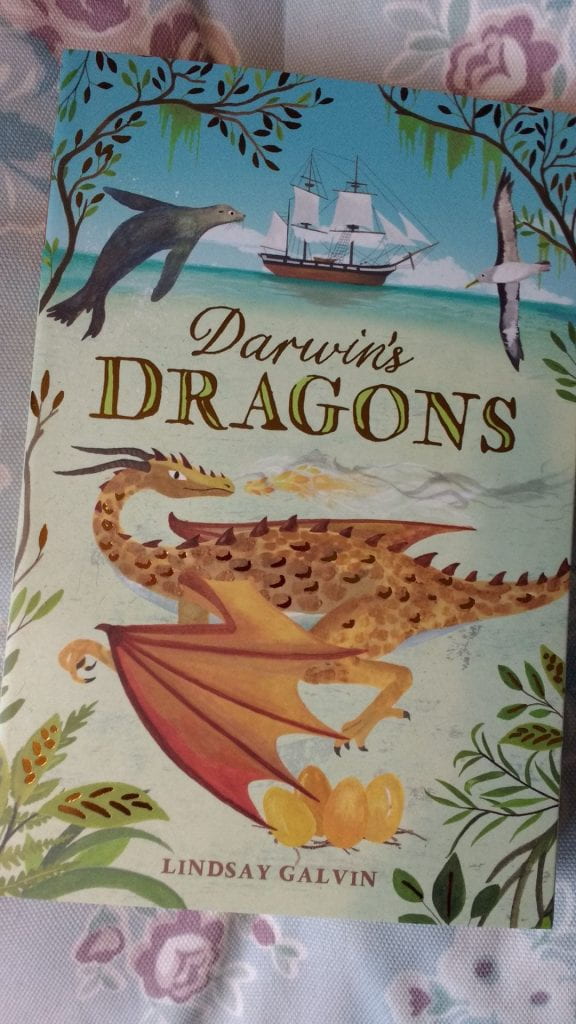 Since the bicentenary of his birth in 1809 there has been a great deal written about the naturalist Charles Darwin. Many of the books focus on his major work “On the Origin of Species”, or they are biographies which cover his whole life. this new book by Lindsay Galvin takes a slightly different tack and covers the period of his time on HMS Beagle from 1831-36. Darwin himself is not even the main character in the story, that honour goes to the young cabin boy Syms Covington, who in real life was promoted to become Darwin’s assistant during the five year voyage.
Since the bicentenary of his birth in 1809 there has been a great deal written about the naturalist Charles Darwin. Many of the books focus on his major work “On the Origin of Species”, or they are biographies which cover his whole life. this new book by Lindsay Galvin takes a slightly different tack and covers the period of his time on HMS Beagle from 1831-36. Darwin himself is not even the main character in the story, that honour goes to the young cabin boy Syms Covington, who in real life was promoted to become Darwin’s assistant during the five year voyage.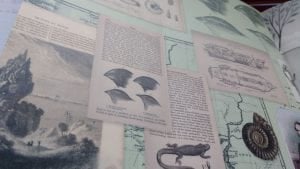 make us think about the way that we treat creatures. In the book, Darwin and other naturalists see the animals as subjects for experimentation and investigation. Whilst they are frustrated when something happens to the creatures, it is just an inconvenience and there is little sense that they have any empathy for the animals they have captured. Luckily Darwin seems to have altered his views somewhat as he grew older and Lindsay Galvin has quoted him as saying “All animals feel wonder and may exhibit curiosity” and also “There is no fundamental difference between man and animals in their ability to feel pleasure and pain, happiness and misery”, both taken from “The Descent of Man” . This story can be read at several different levels and I particularly like all the information at the back of the book, which will encourage young people to read more about the period and the discoveries that were being made. the discussion with the author gives a brilliant insight into how she created the book and what caught her interest at the very beginning. The illustrations are a lovely addition and blend extremely well, but it is the actual cover and the inside covers which are a real ‘Tour de Force’; they are absolutely stunning and make this a very special addition to anyone’s bookshelf.
make us think about the way that we treat creatures. In the book, Darwin and other naturalists see the animals as subjects for experimentation and investigation. Whilst they are frustrated when something happens to the creatures, it is just an inconvenience and there is little sense that they have any empathy for the animals they have captured. Luckily Darwin seems to have altered his views somewhat as he grew older and Lindsay Galvin has quoted him as saying “All animals feel wonder and may exhibit curiosity” and also “There is no fundamental difference between man and animals in their ability to feel pleasure and pain, happiness and misery”, both taken from “The Descent of Man” . This story can be read at several different levels and I particularly like all the information at the back of the book, which will encourage young people to read more about the period and the discoveries that were being made. the discussion with the author gives a brilliant insight into how she created the book and what caught her interest at the very beginning. The illustrations are a lovely addition and blend extremely well, but it is the actual cover and the inside covers which are a real ‘Tour de Force’; they are absolutely stunning and make this a very special addition to anyone’s bookshelf.